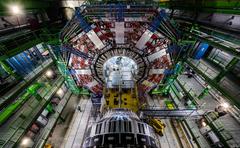URL: https://www.desy.de/news/news_search/index_eng.html
Breadcrumb Navigation
DESY News: The CMS experiment at CERN measures a crucial parameter of the Standard Model
News
News from the DESY research centre
The CMS experiment at CERN measures a crucial parameter of the Standard Model
At the annual Rencontres de Moriond conference last week, the CMS collaboration presented a measurement of the effective leptonic electroweak mixing angle. The result is the most precise measurement of its kind performed at a hadron collider to date, and is in good agreement with the prediction from the Standard Model. Researchers from DESY played key roles in the preparation of this result. The new measurement clarifies how natural forces become mixed when symmetry is broken in our Universe.

View of the CMS detector during maintenance works. Image: CERN
The electroweak mixing angle is a key element of these consistency checks. It is a fundamental parameter of the Standard Model, determining how the unified electroweak interaction gave rise to the electromagnetic and weak interactions through a process known as electroweak symmetry breaking, a process in which the Universe is forced to make an arbitrary choice for fundamental parameters which can affect the masses of particles we observe.
The process can be understood by a common analogy: it is like standing a needle upright, and then seeing which direction it points when it falls down. In this case, the needle falling represents the Higgs field, and when it falls down it fundamentally alters the rules of particle physics. The particles that existed before the Higgs field fell down become mixed together, and the degree of mixing can be visualised by an angle. Measuring this angle is crucial to testing our understanding of particle physics because it relates other parameters to one another, providing an experimental cross-check of the Model.
“With this measurement, we tried to use the CMS detector to its full potential”, says DESY fellow Evan Ranken who was involved in the measurement. “Some of the particles most crucial for measuring the electroweak mixing angle can travel quite close to the beam of colliding protons. There are parts of the detector that are placed close to this beam, and although these components provide important information, they aren't generally used for precision measurement of electrons. But with some creative tools, we managed to do just that."
Extraction of the electroweak mixing angle at the LHC requires physicists to model the movement of quarks and gluons inside the colliding protons. To untangle what is happening when they collide requires a great effort. There are multiple phenomenological approaches which aim to model this behavior empirically, each of which can offer slightly different predictions. All these models rely significantly on data collected at DESY during the operation of the HERA collider from 1992 to 2007. The DESY CMS team led by Katerina Lipka have used their expertise in cutting-edge simulation tools to help maximise the precision of the electroweak mixing angle measurement at CMS, thus playing a key role in interpreting data to obtain the final result. Work performed by the DESY team was essential to ensure that the measurement used the highest-quality simulations available, while also understanding the limits and context of these underlying models in the wider scope of particle physics. “This work not only ensures that CMS can be confident in their result, but also allows the comparison of different modelling approaches, continuing a productive cycle of feedback between theory and experiment,” says DESY researcher Simone Amoroso.
Multiple physical processes with different simulation tools and different forces are involved in modeling the physics result. “To do this you are really engaging with the deepest, most fundamental laws of particle physics all taking place in the subatomic realm of quantum physics. It gives the feeling that one is witnessing the core laws of nature,” says DESY fellow Federico Vazzoler, who provided the interpretation modelling.
The two most precise measurements of the weak mixing angle so far had been performed by experiments at the CERN LEP collider and by the SLD experiment at the Stanford Linear Accelerator Center (SLAC). The values disagree with each other, which had puzzled physicists for over a decade. The new result is in good agreement with the Standard Model prediction and is a step towards resolving the discrepancy between the LEP and SLD measurements.
“This result shows that precision physics can be carried out at hadron colliders,” says Patricia McBride, CMS spokesperson. “The analysis had to handle the challenging environment of LHC Run 2, with an average of 35 simultaneous proton-proton collisions. This paves the way for precision physics at the High-Luminosity LHC, where five times more proton pairs will be colliding simultaneously.”
Precision tests of the Standard Model parameters are the legacy of electron-positron colliders, such as CERN’s LEP, which operated until the year 2000 in the tunnel that now houses the LHC. Electron-positron collisions provide a clean environment for such high-precision measurements. Proton-proton collisions in the LHC are much more challenging for these kind of studies, mainly due to overwhelming backgrounds from the strong interaction processes, coupled with the fact that protons are not elementary particles. Reaching a precision similar to that of an electron-positron collider at the LHC seemed like an impossible task, but with this result it has now been achieved.
The measurement presented by CMS uses a sample of proton-proton collisions collected in 2016–2018 at a centre-of-mass energy of 13 TeV and about 11.000 million million collisions. The mixing angle is obtained through an analysis of angular distributions in collisions where pairs of electrons or muons are produced. This is the most precise measurement of its kind performed at a hadron collider to date, comparable to the precision from electron-positron colliders and improving on previous measurements from ATLAS, CMS and LHCb based on 2012 LHC data.
More information:
- CMS Physics Analysis Summary



